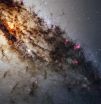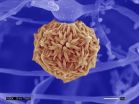The comet was visited last fall by NASA's Deep Impact spacecraft during its EPOXI mission. The EPOXI science team's new, in-depth analysis of the images and data taken during the flyby confirms its earlier finding that carbon dioxide is the volatile fuel for Hartley 2's ice-spewing jets.
In-depth analysis of the images and data taken during the flyby of the comet last fall by NASA's Deep Impact spacecraft confirms that carbon dioxide is the volatile fuel for Hartley 2's spectacular ice-spewing jets.
The study also provides several new twists in the unfolding story of this small cometary dynamo including that: (1) the smooth, relatively inactive waist of the peanut shaped comet is likely re-deposited, and thus evolutionary rather than primordial material; (2) Hartley 2 has an 'excited state of rotation' because it spins around one axis, but also tumbles around a different axis; and (3) on its larger, rougher ends, the comet's surface is dotted with glittering, blocky objects that can reach approximately 165 feet (50 meters) high and 260 feet (80 meters) wide.
"Hartley 2 is a hyperactive little comet, spewing out more water than other comets its size," said University of Maryland Astronomer Michael A'Hearn, who is lead author on the Science paper and principal investigator for the EPOXI and Deep Impact missions."When warmed by the sun, dry ice [frozen carbon dioxide] deep in the comet's body turns to gas jetting off the comet and dragging water ice with it.
"Although, Hartley 2 is the only such hyperactive comet visited by a spacecraft, we know of at least a dozen other comets that also are relatively high in activity for their size and which are probably driven by carbon dioxide or carbon monoxide," said A'Hearn, who won the 2008 Kuiper astronomy prize for seminal contributions over his career to the study of comets. "These could represent a separate class of hyperactive comets or just a continuum in comet activity extending from Hartley 2-like comets all the way to the much less active, 'normal' comets that we are more used to seeing."
The EPOXI mission found that the strong activity in water release and carbon dioxide-powered jets did not occur equally in the different regions of the comet. During the spacecraft's flyby of the comet – with closest approach of 431 miles (694 km) on November 4, 2011 -- carbon dioxide driven jets were seen at the ends of the comet with most occurring at the small end. The water ice particles driven out by these jets created a "snowstorm" through which the spacecraft flew. In the middle region or waist of the comet, water was released as vapor with very little carbon dioxide or ice. The latter findings indicate that material in the waist is likely a product of the activity at the ends of the comet, the researchers say.
"We think the waist is a deposit of material from other parts of the comet, our first evidence of redistribution on a comet," said University of Maryland Astronomy Professor Jessica Sunshine, who is deputy principal investigator for the EPOXI mission. "The most likely mechanism is that some fraction of the dust, icy chunks, and other material coming off the ends of the comet are moving slowly enough to be captured by even the very weak gravity of this small comet. This material then falls back into the lowest point, the middle," said Sunshine, who is principal investigator for Comet Hopper, a mission proposal that is a finalist for selection by NASA as a new planetary mission in the agency's Discovery Program.
The researchers also say that their EPOXI findings indicate the small end of the comet appears to release about twice as much carbon dioxide relative to the amount of water released than does the large end. If true, they write, this difference almost certainly indicates a primordial difference in composition between the two ends, a difference present since this comet's formation.
However, they note that for now this is still a tenuous conclusion. The complex rotation and tumble of Hartley 2 makes it hard to definitively correlate differences in carbon dioxide to water ratios with compositional differences for the two ends of the comet.
"Not only does the total brightness of Hartley 2 vary, but the dust and gas structures in its coma show occasional 'hiccups' over the course of several rotations, phenomena characteristic of a complex rotation state," said study coauthor Tony Farnham, an associate research scientist at the University of Maryland. "These observations suggest that there is something unique about the activity on Hartley 2 that has a major influence on its dynamical state."
In comets, the release of dust and water vapor and the activation of carbon dioxide (and other volatiles) jets are the result of solar heating on the sunward side of a comet. Thus, a complete understanding of how the dual axis rotations affect the amount solar heating that each end of the comet receives is needed in order to determine how much solar heating versus true primordial compositional differences influenced the type and amount of material that is observed streaming out of the comet at both ends.
"Ground based observations can measure, over a much longer period of time, the rotational behavior of Hartley 2, as well as the compositional variations in the extended coma, the cloud of dust and gas surrounding the body of the comet," said coauthor Lori Feaga, an assistant research scientist at the University of Maryland. "Several other research groups have made such observations of the comet, and their finding will assist us in jointly disentangling the underlying cause of Hartley 2's heterogeneity."
The study notes that another EPOXI discovery is that on the knobby ends of Hartley 2, particularly the smaller end, the surface terrain is dotted with block-like, shiny objects, some as big as a block-long, 16-story-tall building – tops of 165 feet (50 meters) high and 260 feet (80 meters) wide. The study says the objects appear to be two to three times more reflective than the surface average.
"These are spectacular features, but at this point we don't know whether these are deposits or growths, or something else," said Sunshine.
DEEP IMPACT ON COMET SCIENCE
Comets are fundamental building blocks of the giant planets and may have been an important source by which water and organics -- the essentials of life as we know it -- came to Earth.
On its EPOXI mission the Deep Impact spacecraft flew by Hartley 2 on Nov. 4, 2010, just a few weeks after the comet had passed within 11 million miles of Earth. Equipped with two telescopes with digital color cameras and a near-infrared spectrometer, the spacecraft beamed back more than 117,000 images and spectra of Hartley 2 during an imaging period encompassing 2 months on approach of the comet and 3 weeks on departure.
With its EPOXI mission data, the Deep Impact spacecraft added to its extensive scientific legacy. Launched in January 2005, the spacecraft made history and world-wide headlines when it smashed a probe into comet Tempel 1 on July 4th of that year. Following the conclusion of that mission, a Maryland-led team of scientists won approval from NASA to fly the Deep Impact spacecraft to a second comet as part of an extended mission named EPOXI (Extrasolar Planet Observation and Deep Impact Extended Investigation).
The spacecraft remains in excellent condition, but has no fuel for future travels. Use of the spacecraft as an orbiting observatory remains possible.
INFORMATION:
NASA's Jet Propulsion Laboratory, Pasadena, Calif., managed the EPOXI and Deep Impact missions for NASA's Science Mission Directorate, Washington. The University of Maryland, College Park, is home to Michael A'Hearn, principal investigator for both missions, and many other members of the EPOXI and Deep Impact science teams. Drake Deming of NASA's Goddard Space Flight Center, Greenbelt, Md., is the science lead for the EPOXI mission's extrasolar planet observations. The spacecraft was built for NASA by Ball Aerospace & Technologies Corp., Boulder, Colo.
END





